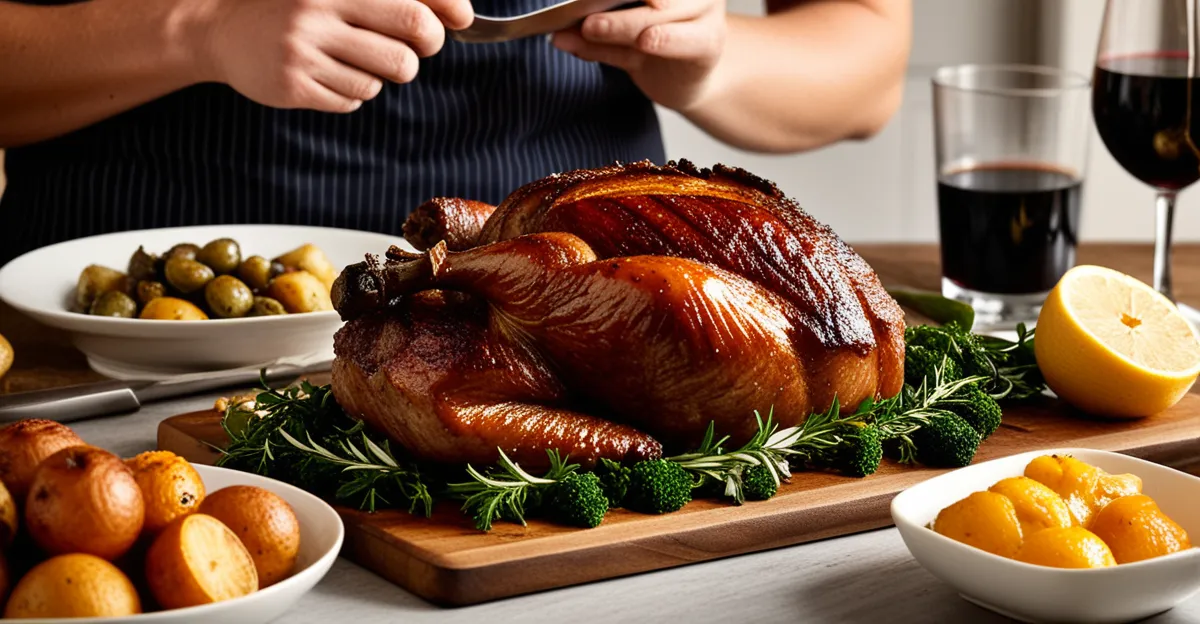Understanding the Components of a Perfect Sunday Roast
To create the perfect Sunday roast, it’s essential to consider all its core components. A traditional Sunday roast usually consists of roast meat, potatoes, vegetables, Yorkshire pudding, and gravy. These ingredients come together to form a harmonious meal that’s deeply rooted in British culinary tradition.
The choice of quality ingredients for each component is crucial. For the roast meat, cuts of beef, lamb, chicken, or pork are popular options, each offering distinct flavors. Potatoes should be fluffy inside and crispy outside, often achieved through a combination of parboiling and roasting. Vegetables, either seasonal or classic additions like carrots and parsnips, bring color and nutrition. Yorkshire pudding and gravy bind these elements together, with the former providing a light, crisp texture and the latter offering a flavorful sauce primarily made from pan drippings.
Also to read : How can you master the art of crafting a traditional Lancashire hotpot?
For those with dietary preferences, adaptations can be made, such as using vegetarian substitutes for the meat or opting for gluten-free Yorkshire puddings. This versatility allows the Sunday roast to evolve with changing tastes while retaining its comforting essence. By carefully considering each element’s preparation and quality, anyone can enjoy a delightful and satisfying roast meal.
Selecting the Ideal Roast Meat
Choosing the right roast meat is a cornerstone of crafting a memorable Sunday roast. The decision on which type of meat to use can significantly impact the overall taste and presentation of the meal.
Also to read : What are some iconic UK desserts to try at home?
Types of Roast Meat
- Beef: Known for its rich flavor, beef is a classic choice. Consider cuts like rib roast or sirloin for balanced marbling.
- Lamb: Offers a distinct, gamey taste. Popular cuts include leg and shoulder.
- Chicken: A versatile option, often appreciated for its lighter flavor. Whole roasting provides a crispy skin.
- Pork: Known for its savory goodness. Cuts like loin and shoulder are recommended for their tenderness.
Recommended Cuts for Optimal Flavor
Selecting the right cut of meat is crucial. For beef, a well-marbled cut such as rib roast enhances juiciness and flavor. Lamb shoulder, with its connective tissue, benefits from slow cooking for tenderness. Chicken can be best enjoyed when roasted whole, while pork shoulder, due to its fat content, remains juicy.
Cooking Methods and Their Effects
Each cooking method offers unique benefits. Roasting is ideal for achieving a crispy exterior. Slow cooking tenderizes tougher cuts, infusing them with flavor over time. Sous-vide techniques can be used to achieve precise temperature control, allowing for consistent results and enhanced flavors. Understanding these methods lets you tailor the preparation to your preferred meat, ensuring a delectable Sunday roast.
Perfecting the Trimmings
To elevate your Sunday roast experience, paying attention to the trimmings is as important as selecting the main component. Mastering the art of preparing each accompaniment will ensure a harmonious and delightful meal.
Preparing the Perfect Roast Potatoes
Achieving the ideal roast potatoes requires careful preparation techniques. Begin by choosing the right variety, such as Maris Piper or King Edward, known for becoming fluffy inside and crispy outside. Parboiling them before roasting ensures a soft interior, while a gentle shake after boiling creates surfaces that crisp up beautifully in the oven. Roast potatoes are best cooked in hot fat, such as goose fat or olive oil, for an irresistible golden exterior.
Cooking Seasonal Vegetables
Seasonal vegetables not only bring vibrancy and nourishment to the table but also complement the flavors of the Sunday roast. Opt for carrots, parsnips, or Brussels sprouts, which are traditional favorites. Cooking methods such as roasting or steaming can enhance their natural sweetness. A light seasoning of herbs or a glaze of honey ensures these vegetables are as appetizing as they are nutritious.
Making Yorkshire Pudding
Yorkshire pudding is a quintessential element of a Sunday roast, providing a delightful texture contrast. To perfect this side dish, focus on crafting a smooth batter using equal parts of egg, flour, and milk, and allowing it to rest. The key to success is baking in a preheated oven, preferably in a hot pan with some oil or fat, creating a pud that is light, airy, and crisp. Mastering Yorkshire pudding will add an authentic touch to your meal.
Crafting the Ideal Gravy
One of the most essential elements that ties a Sunday roast together is a well-prepared gravy. It’s not just a sauce, but a flavour ambassador of your roast, elevating each component it touches.
To start, a traditional gravy preparation typically uses the rich pan drippings from the roast meat as the base, infusing it with intense, savory flavours. This is crucial for capturing the essence of the roast, whether it be from beef, lamb, pork, or chicken. The art of gravy-making involves deglazing these drippings with stock or wine, ensuring that each drop of flavor is savoured.
Thickening techniques bring the gravy to its desired consistency. Using a roux made from butter and flour is a classic method, providing a smooth, glossy finish. Alternatively, a slurry of cornstarch and water can be used, especially for those seeking a gluten-free option. It’s about finding the balance, where the gravy clings to meat and potatoes without overwhelming them.
For an extra boost, consider adding flavor enhancements like fresh herbs or a splash of Worcestershire sauce, allowing the gravy to harmonize with the accompanying dishes. Mastering these techniques ensures that the gravy not only binds the meal but also enhances the flavor of every bite.
Timing Your Sunday Roast
Timing is a crucial factor in crafting the perfect Sunday roast, ensuring all components are ready at once for a seamless dining experience.
Creating a Cooking Schedule
Establishing a detailed cooking timeline is the key to coordinating a flawless meal. Begin by identifying the cooking times for each essential ingredient, starting with the roast meat that typically requires the longest duration. Calculate backward from your intended serving time to determine when to start each dish. This strategy ensures that meats, vegetables, and side dishes like Yorkshire pudding are completed concurrently, maintaining freshness and warmth.
Managing Oven Space Efficiently
Efficient use of oven space is vital given the array of dishes involved. Consider appliance capacity and the possibility of cooking multiple components simultaneously. This might involve using oven-safe racks or baking trays to accommodate different items at varied heights, crucial for successful meal preparation. Use the stovetop for options like gravy, freeing up valuable oven real estate.
Ensuring All Components Are Ready Together
Achieving synchronization in meal preparation sharpens the mastery of crafting a Sunday roast. Employ techniques like resting your meat, which not only enhances its flavor but also frees up oven space for final touches on other dishes. Develop a routine or checklist to visually track progress, ensuring that everything from roast to vegetables meets the table at the perfect temperature, pledging a harmonious and satisfying family meal occasion.
Pairing Wine and Other Enhancements
A Sunday roast transcends from a meal to an experience with the correct pairings and enhancements. The selection of wine can elevate the flavors of your meal preparation, complementing each component with finesse.
Wine Pairings by Meat Type
Selecting a wine involves aligning its flavor profile with your choice of roast meat. For beef, a full-bodied red like Cabernet Sauvignon can accentuate the rich, hearty flavors. Lamb pairs well with a Syrah or Chianti, adding depth to its gamey taste. A crispy Sauvignon Blanc or Chardonnay complements the subtler flavors of roast chicken, while a medium-bodied Merlot complements pork well. These pairings enhance the dining experience, drawing out the nuanced flavors of your roast.
Complementary Side Dishes and Sauces
Beyond wine, consider the side dishes and sauces that play crucial roles in meal enhancement. Adding a root vegetable mash or a tangy cranberry relish can provide contrasting textures and flavors, lifting the entire Sunday roast ensemble. A creamy horseradish sauce for beef or a mint jelly with lamb enriches each bite, sharing the stage with the main meat while adding layers of flavor complexity.
Presentation and Visual Appeal
Setting the perfect table is crucial in elevating the roast from a regular meal to an event. Use a coordinated color palette for your tableware and napery to harmonize with the savory hues of your dishes. Incorporate garnishes like fresh rosemary sprigs or edible flowers to add visual intrigue and a touch of sophistication. A well-presented Sunday roast can leave a lasting impression, making the meal memorable for all.




